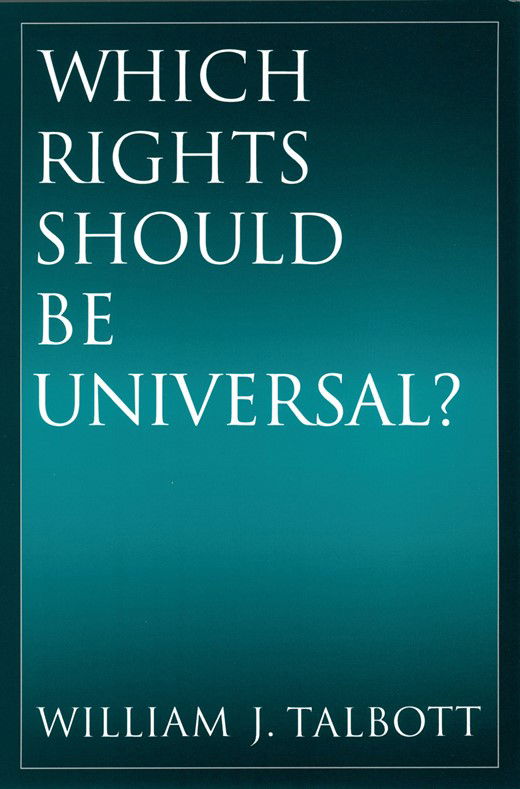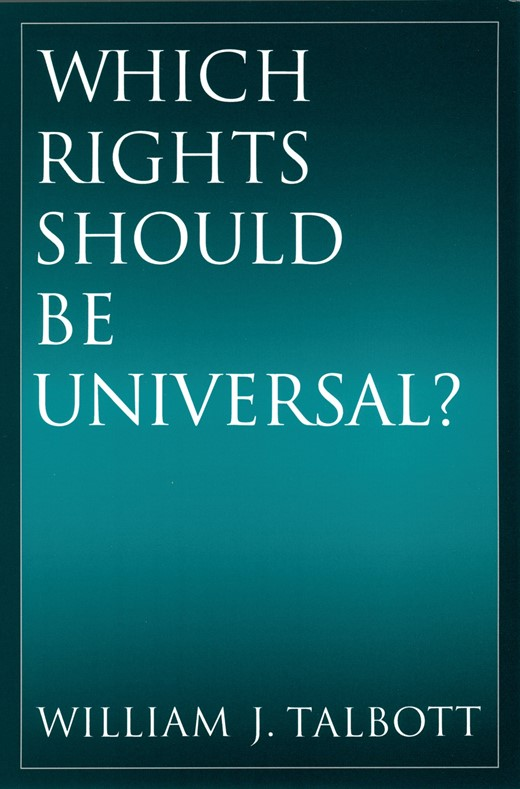William J. Talbott, Which Rights Should be Universal


William J. Talbott, Which Rights Should be Universal (Oxford University Press, 2005)
William Talbott believes that certain rights are in some sense universal–applicable to all human beings with the capacity for autonomy, and perhaps many non-human animals as well. Now, when someone says that this or that alleged entitlement is a human right, there is an important ambiguity that may arise. They may mean that the alleged prerogative (let’s say making fun of some political figure) is a protected activity, something for which no one can be punished–at least in a particular jurisdiction. Alternatively, they may be saying that, whether or not the government in question currently protects these kinds of activities, making it immune from punishment, every government should do so. That means that when someone makes a list of what they claim to be the most important human (or animal) “rights,” they could be talking either about what is actually protected somewhere, or what they think should be the case (everywhere).
This is a distinction that Talbott makes quite clearly in Which Rights Should be Universal? When he proposes his favored list of basic universal rights, he is under no delusion that the activities described in each are now protected (or provided) anywhere–still less that they have been protected (or provided) everywhere since humans have populated the earth. He writes, “How could it make sense to think that the members of a prehistoric human community might have had rights, when no one had ever had such a thought?” And he points out that those believing in “natural rights” have often answered this question by saying that God “endowed” human beings with the entitlement to the items in question. On that view, everyone should have always had the activities or goods protected or provided–even before the idea occurred to anybody (but God).
But Talbott has a different perspective: “the proposition that human beings should have certain legally protected basic rights is a partly moral, partly empirical discovery….[I]t is a mistake to think that members of prehistoric human communities should have respected each other’s basic rights. However...the members of those communities had characteristics which…explain why certain basic rights should be universally protected.” So…how do we figure out what they are?
No moral judgment is infallible, Talbott writes, but we need not be skeptics because of that. If we take a “bottom-up” approach: study history, gain a wide variety of personal experience, consider hypothetical situations, attempt to empathize with others and free ourselves of biases, we can, through a process of constantly forging equilibria between our moral intuitions and the propositions we take to express universal moral claims, make increasingly reliable universal moral assertions. That is the manner in which Talbott argues we can ascertain what rights should be understood to be universal.
The most famous historic declarations of rights, those with which we are quite likely to be familiar, have usually included claims of self-evidence, based on the theory that our Creator “endowed” everyone with them. On that view, any rational mortal should be able to tell for certain that we all have these “natural rights.” As indicated above, however, Talbott argues that that approach is wrong-headed, claiming that reliance on such “top-down” demonstrations–from incorrigible universal principles to individual moral judgments is backwards. He believes that our reasoning should move in the other direction, for example, from our forceful intuitions that it’s wrong for Jessica to kick her baby to the universal moral principles that explain those intuitions. He’s a fallibilist about this sort of reasoning: we can never be sure we’ve landed upon exactly the right universal principles: in fact we can always be pretty sure that we haven’t gotten them quite right. But just because we can’t be certain, it shouldn’t be thought that we have no evidence for our moral judgments at all.
Talbott’s approach seems to me plausible, although I doubt that it’s really so different from the “top-down” method he derides. For I think if anybody asked Jefferson why he thought everybody has an inalienable right to “the pursuit of happiness,” he would have appealed to the same sort of individual intuitions appealed to by Talbott. That is, on some level, our emotional responses of, e.g., repulsion or empathy toward this or that occurrence, have always been understood on some level to function as (perhaps the only) evidence on which anyone who does not define goodness in terms of some sort of “utility” can rely for the assertion of any universal moral principle. That is, it seems to me that it is really only the (philosophical) assertions regarding the relationships between the intuitions and the ostensible principles that have altered–if anything at all has.
It has always been widely understood that one can take the regular occurrence of a particular emotion among lots of different people when they are in situations of the same type to be evidence for some moral principle that applies to those sorts of emotion-producing occurrences. As Talbott puts it, the principle will then be thought to EXPLAIN the arising of an emotion in specific situations. Thus, the reason we are overwhelmed with disgust when Jessica kicks her baby is that it is wrong to kick babies.
One problem with that analysis is that this way of putting the matter goes farther than many empiricists will allow. More favorable to causes than other s0rts of explanations, they will likely say that the reason for the emotion of disgust is empathy or prior instruction, whether or not it is actually morally wrong to kick babies. It’s different for prudential values (what is good FOR an individual or group). While we may be able to concoct an empirical theory essentially connecting emotions with prudential results like happiness, it is hard to see how to make that sort of connection with ethical values in the absence of a background theory regarding what moral values actually ARE.
Talbott seems to think he will be safe in making the ethical claims he does if he insists on fallibilism, that he may always be wrong in the assertion of any universal moral principle; but that’s not really the problem. What he needs to show is that ANY moral (and therefore non-empirical) state of affairs can properly CAUSE or otherwise EXPLAIN the truth of moral proposition without violating Moore’s “naturalistic fallacy.” How is it, exactly, that a moral principle can explain a feeling of disgust?
Talbott is very good on the deficiencies of cultural, and other varieties of moral relativism, especially when used to attack “moral imperialism.” Essentially, the idea is that even a defense of tolerance toward the practices of other cultures could itself be criticized as an example of imperialism. His problems with relativism cause him to display a self-characterized “metaphysical immodesty” with respect to moral propositions, which he takes to be perfectly consistent with his epistemological modesty regarding any particular moral principle. His view is that we will get closer and closer to finding perfect principles by examining the progress of various peoples’ attitudes toward real and hypothesized events through the course of history. For he holds that “the main design problem of politics is to design a system of government that will be appropriately sensitive to the factors that determine the justice or injustice of its actions, so that it will tend to act in ways that are just and not to act in ways that are unjust.” This requires both reliable feedback and appropriate responsiveness to that feedback. (I take it that the recent SCOTUS decision according to which sitting Presidents can do pretty much anything they like with impunity may not fit too well with what Talbott takes to have been the main goal of the U.S. Constitution writers: to address the “culturally universal moral problem of government abuse of its coercive powers.” I suppose, though, that some will find his optimism rehabilitating.) I agree, in any case, that knowing that objectively true moral propositions exist does not require that anybody knows what they are. Somewhat confusingly (and I think incorrectly) he objects to moral skepticism because he doesn’t see “how it could make more sense to believe that nothing…is morally wrong than to believe that at least some things are morally wrong.” But the moral skeptic need not–indeed cannot–hold that nothing is morally wrong, for her skepticism necessarily involves her inability to know anything like that.
There are a fair number of such little errors of this type involving confusions between being and being known that can be found in this book. Here’s another example: Talbot writes that “To make a universal judgment that the conquistador’s treatment of the American natives was wrong is to assert that the conquistador and his culture were mistaken about how they should have treated the American natives.” That’s not quite right because one may make such a judgment about the conquistador’s behavior without making any particular assertion about what anybody happens to think when they do something that seems evil. If one judges that the conquistadors were wrong, we may assume that they WERE mistaken about moral matters, but they need not have been. Maybe they just weren’t thinking about such stuff at all. Again, he writes that “to say that moral judgments are universal is just to say that when two disputents disagree on a particular moral judgment, at least one of them is mistaken.” But as Everett Hall explained back in 1959, it is better to understand moral judgments as having the three possible values of legitimacy, illegitimacy and non-legitimacy, rather than only the two truth values that factual propositions can have. I want to stress, however, that none of these “little errors” are terribly important to the force and importance of Talbott’s main argument. Furthermore, he has likely been more careful in the longer–and much denser–sequel to this book that he published several years later.
Talbott analogizes this process of learning moral values to advances in science, where some experiments confirm and others overturn applicable theories. As suggested above, I think there is an important difference, however. In the physical sciences, there is a fairly comprehensive and widely accepted “folk theory” involving, e.g., light, sounds, smells, etc. impinging on our sense organs. This picture has come to be explained by the developing sciences of physics and biology. But there seems nothing comparable to a folk theory of “the morally real.” If we generally agreed that goodness is a simple property or that it is reducible to something like pleasure, it’s possible that the analogy to science might work–and perhaps it does for prudential (rather than moral) values because we have a primitive empirical sense of well-being. But there is simply no widely accepted “folk” version of what is going on in the world of ethics. Are things good because God likes them? Or is it because they are, on balance, pleasure producing? Or because they satisfy desires? Talbott doesn’t accept any of these reductions, and he’s hardly alone in that. But such reluctance is problematic for his analogy. In the world of facts, we attempt to “save our phenomenal appearances” with a theory that is also required to comport in a coherent manner with our folk theory. In the world of ethics, goodness, badness, rightness, and wrongness are left as items for which there is no explanation other than the experiential causes that undeniably lead to our judgments. But without the intervening bridge of a“folk theory,” our ethical explanations must end up either as axioms without basis or tautologies providing no additional information.
I distinguished above between rights that are “protected” and rights that are “provided” by governments. The point of using those two terms is to make the traditional distinction between “negative” rights, like free speech or “conscience”–in which the role of government is solely to make sure nobody is deprived of something they seem to have been born with; and “positive” ones, say, to clean water or elementary education or “decent housing.” For the latter, it will usually not be sufficient for governments simply to prevent people from being overtly harmed by anyone; rights are violated if certain positive goods aren’t made available to everyone. (It is interesting to note in this context that the “God-endowed, inalienable” theory comports more cleanly with the negative variety of rights.) On Talbott’s view, these two sorts of rights have something important in common because he believes both of them are justifiable by their role in enhancing autonomy. Talbott introduces a similar bipartite division, however: Exercise-of-Judgment rights and Development-of-Judgment Rights. The “exercise” batch are predominantly negative because we can hardly “exercise” some capacity we don’t already have, and the “development” batch are mostly positive. But there seems more bleeding between categories here.
Talbott writes, “Sometimes human rights are presented as protections against things so obviously bad that no one could reasonably disagree about their badness. Torture, rape, and murder are obvious examples. Human rights guarantees do play this role. But…distinctively human rights…provide the necessary background conditions to enable a person to develop her own conception of a good life and to form, evaluate, and pursue a life plan. This is part of what it is to be autonomous.” He warns us that while outsiders should be allowed to “morally criticize internal practicessuch as foot binding and female genital cutting, it is a mistake to think that the guiding idea behind human rights is the elimination of such evils.” Rather, he insists that “the guiding idea behind human rights is to enable all people to develop and exercise autonomy, to become the authors of their own lives.” This, in turn, has been a matter of “a centuries long process of understanding the conditions necessary to be able to form, evaluate, and pursue life plans.”
So, what are the universal rights? In order to quickly answer this question, I will skip over two of Talbott’s fascinating historical discussions regarding how those in positions of power gradually came to yield some of their authority to those who had hitherto been seen as less than human. I refer here first to the matter of how a pious conquistador like Bartolome de Las Casas could, in the violent environment of an intolerant Christian theocracy, come to take a liberal position on what the “idolatrous” (and sometimes cannibalistic!) Incas should be allowed to think and do, and second, to the slow securing of rights to property, the vote, etc. by women in various jurisdictions around the world.
Leaving those important issues, perhaps for elaboration at other places/times, here is Talbott’s list of the basic universal rights:
- The right to physical security
- The right to physical subsistence (understood as a right to an opportunity to earn subsistence for those who are able to do so)
- children’s rights to what is necessary for normal physical, cognitive, emotional, and behavioral development
- The right to an education
- The right to freedom of the press
- The right to freedom of thought and expression
- The right to freedom of association
- The right to a sphere of personal autonomy free from paternalistic interference
He also adds the following provision in an extremely discursive chapter on democracy:
- Political rights, including democratic rights and an independent judiciary to enforce the entire package of rights
One big problem with that chapter (which really is all over the place) is that while Talbott frequently uses the phrase “rights-respecting democracy,” he never bothers to tell us precisely what makes a polity a democracy in the first place. He just says that political rights should be understood to include a right to vote, to engage in political opposition, and to run for office, and should also be thought to include “an independent judiciary.” Is the U.S., with its Electoral College and Senate really a democracy? Is Russia? Hungary? Is the U.S. Supreme Court “independent” if its Justices can be bought with the presentation of free RVs? Furthermore, Talbott doesn’t clearly distinguish “democracy rights” from political rights (many of which had already been mentioned).
Anyhow, it’s a rich, thoughtful book, which covers most of the main issues currently facing political theorists, and is chock full of engaging arguments. Indeed, I believe too many subjects are covered, too many terms are introduced, and too much optimism is displayed for our age of Trump and Orban. But Talbott does express one disturbing truth quite eloquently: “Ultimately, the stability of…democracies and their ability to improve over time depend crucially on there being enough voters who are able to adopt the moral standpoint to make fairness judgments… [and to show a] willingness to bear at least small costs in order to promote fairness….[Without those characteristics, democracies can be expected to] oppress minorities and [will not] improve themselves over time.” I, for one, think the book might be recommended for that prescient remark alone.

About the Author
Walter Horn is a philosopher of politics and epistemology.
His 3:16 interview is here.
Other Hornbook of Democracy Book Reviews
His blog is here